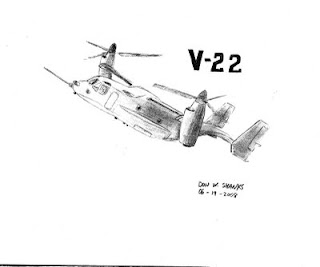Recently, I was checking out
Space.com and found a article by
Leonard David entitled,
“DC-X Honored for Its Contributions, Potential.” Dated September 1, 2008. I want to quote the opening of that article here. “Creating routine, aircraft-like, low-cost access to space is not only technologically challenging, it will require enormous tenacity to overcome the inevitable bureaucratic, political and funding hiccups. These are just a few of the lessons learned by veterans of the
Delta Clipper-Experimental (DC-X) rocket ship program.” The program ran from 1991 to 1997. A unlikely (in today's climate) of government, industry, and that special group of humans called entrepreneurs. The
DC-X was a technology demonstrator designed to test out concepts for a single-stage-to-orbit spacecraft that took off and landed vertically. A vehicle that had potential in both civilian and military space travel.
I personally was in my 30s, taking a airframe and power-plant mechanic course to get my license in 1990-1991. And back then, I had a subscription to
Aviation Week & Space Technology which I have maintained more or less since I was in college. There were a few years where I had to do without that subscription. But getting back to the
DC-X story – I just ate it up whenever something new came out about that vehicle. My personal view on the subject matter as to why
DC-X failed and
Lockheed/Martin's Venture Star won the Clinton's administration's decision was due to politics and campaign funding. And we all know what happened to
Venture Star now don't we....
But, getting back to Leonard David's article that is paraphrased below:
Before
Boeing bought out
McDonnell Douglas, they were in partnership with what was known as the
Strategic Defense Initiative Organization. The
DC-X first flew on August 18, 1993 two years after receiving the funding go-ahead. Tests were conducted at
White Sands Missile Range. The
DC-X flew 8 times between August 1993 and July 1995. Then there was an advanced
DC-X that flew four times in 1996 until on its last flight, the vehicle tipped over and was destroyed. The accident was due to human error dealing with one of the craft's four landing legs.
Mr. Leonard David covered their 15th anniversary reunion held on August 17-19, 2008 that was hosted by the
New Mexico Museum of Space History that was the start for fund raising in order to develop a permanent
DC-X/XA exhibit at that museum. David interviewed
Bill Gaubatz, the former director for the
Delta Clipper programs at
McDonnell Douglas. He (
Gaubatz) stated: “The
DC-X and
XA showed that a small dedicated government and industry team with focused objectives could make significant advances with the boundaries of a limited schedule and budget.”
Gaubatz also added that the total amount of money spent of the
DC-X/XA program was less than $100 million, including range and lab costs. We were in effect, a little entrepreneurial team working within a big company, that was working for a this-can-be-done philosophy and a vision to drive launch costs below $100.00 a pound.
Additionally, Mr.
Gaubatz said, “I'm convinced that if the
DC-X program hadn't been terminated, we would have been in regular trips to orbit now. We may or may not have been a
single-stage-to-orbit, but we would have been totally reusable, safe, rapid-turnaround transportation system. Cheap, unsafe access is not the way to go.”
The
DC-X promised aircraft like access to space operations. Rapid prototyping as shown by the
DC-X program would have goaded other “older” space companies to get involved in their own development of less-expensive space vehicles.
The first civilian director of the
SDI was
Ambassador Henry Cooper who helped provided the funding needed to get the program started back in 1990. Mr.
Cooper said “That he thought the step-by-step
DC-X rocket program would pay for itself during its development by launching suborbital targets for missile defense interceptors. (Note: President
Bill Clinton's administration cut funding in 1993 in order “to take the stars out of star wars.” That decision that resulted in the cancellation of the
DC-X program and turned off all innovative technological progress within the
Strategic Defense Initiative).
Ambassador Cooper added, “The regrettable part is that we knew how to do this job 15 years ago. It can be done better today. The technology has moved on in spite of the government not investing in it in some cases... or not investing as much as in it.” Bill Gaubatz provided some additional thoughts, “That
DC-X termination brought about two great losses, dispersal of the team that worked on it and the loss of time.”
Jess Sponable,
U.S. Air Force (retired) was the
USAF program manager for the
SSTO (
Single-Stage-To-Orbit) technology program. He stated that the
DC-X focus was demonstrating a reusable rocket that operates with aircraft-like operability. “We learned a lot about what to do... but we learned a lot about what not to do.” Sponable offered up the concept of the transportable elements of the
DC-X, including the trailer-filled flight operations control center. “There's no reason we can't take a similar approach in the future for how we do launch systems.” This underscored that the cost per flight was generally in the $200,000 to $300,000 range. “We were the last program to actually combine and accomplish faster, cheaper, and better... all at the same time. The seeds have been planted. The future is coming and it won't be stopped by bureaucratic setbacks. Low cost space access is coming and it will happen.”
Jess Sponable told Mr. David.
Several attendees pointed to
Scaled Composites and its work on the
White Knight Two – the flying launch pad to support, in part, suborbital, passenger-carrying space liner operations, as well as efforts now under way at
XCOR Aerospace,
Armadillo Aerospace, and
Masten Space Systems among others.
Rick Bachtel, general manager of operations for
Pratt & Whitney Rocketdyne of
Huntsville, Ala. Said, “What I see in the future is not government funding as much as it is going to be commercial.”
Bachtel told reporter Mr. David, that his company has spun off a smaller group called
Power Innovations to harness inventive and entrepreneurial ideas. The approach is to tap the firm's 3,000 to 4,000 engineers and bring ideas into the smaller group to spin off innovative technologies.
Leonard David goes on with his article by speaking with
NASA administrator
Mike Griffin, the former deputy for the
SDI organization and a leader in the
DC-X program. Taking the title from a popular book and
HBO series about a group of soldiers,
Mike Griffin referred to those who worked on the
DC-X as a “Band of Brothers.” It is people that make the hard work of aerospace engineering indistinguishable from magic.”
Griffin told attendees to this event. “Today a small private team can accomplish suborbital human spaceflight, a feat that once took the resources of a government to achieve. I'm personally convinced that manned orbital flight is within reach just barely of private enterprise today.” He went on referring that the
United States has not followed up the
DC-X with the kinds of technology that could revolutionize space transportation. “We need better propulsion, better materials, we need more investment into the technology of operations, which is at least half the cost. We need to create new paradigms in thinking of how we operate, just the way
DC-X did. That doesn't come for free. And right now, policy makers don't seem to be willing to allocate that kind of money.”
Former
SDI and shuttle astronaut
Gary Payton, now deputy undersecretary of the Air Force for space programs compared
DC-X to what is now know as
Operationally Responsive Space. Payton was also
NASA's deputy associate administrator for space transportation technology where he initiated, planned and lead the
Reusable Launch Vehicle technology demonstration program which included the
DC-XA flight test project. “The military needs short noticed, quick response, easy changes to the launch vehicle's ascent guidance in order to reconstitute lost space assets – sounds like it fits some of the things we were doing in
DC-X.” Parts of the
DC-X program are finding their way into the
Operationally Responsive Space.
Well, that's Mr. David's article pretty much. Too much information to actually try to summarize although I probably could have if I really tried. I pretty much quoted the entire article because I really believed in the whole concept behind
DC-X. In fact, when speaking with friends, I would refer to this vehicle as the “First
Dropship.” For those of you who have ever played the game
Battletech, you will know what that means. Those of you who have not –
Battletech is a game set in the 31st century and the Inner Sphere is always at war with one another.
Jumpships travel between start systems. They carry
Dropships. A
Dropship is a huge vessel capable of transporting several military vehicles known as
BattleMechs, giant, robot like in appearance; they each have as much or more firepower than a 20th century tank platoon.
But, getting back to the
DC-X. The U.S. Government is now stuck with
Orion. They got their blinders on and cannot think of something else to do. Not that Congress would provide the funding anyway. It is going to take some future
Virign Galactic/Scale Composites or some other company partnership to get
Boeing off it's rear end and create the
DC-X2 – the second generation.
Finally, I don't know if anybody else thought of this but, the
DC-X could form the core element for a future
Mars Lander. Maybe I can live long enough to witness the
DC-X Phoenix class dropships traveling to
Mars. I hope that it could be true.
(Ref. Space.com. September 1, 2008 “DC-X Honored for Its Contributions, Potential.” by Leonard David, Special Correspondent for Space.com. Dateline was Alamogordo, NM.).





.jpg)















+033.jpg)